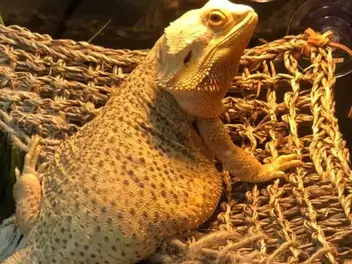Obesity is a major health concern for pet bearded dragons. An bearded dragon overweight is at risk for serious medical issues including fatty liver disease and metabolic bone disease. As responsible pet owners, it’s important that we monitor our bearded dragon’s weight and take steps to prevent obesity. In this article, we’ll examine the causes of obesity in bearded dragons, signs that your pet is overweight, and tips for helping an obese bearded dragon get back to a healthy weight.
What Causes Obesity in Bearded Dragons?

There are a few key factors that can lead to obesity in bearded dragons:
Overfeeding
Bearded dragons are prone to overeating if given unlimited access to food. It’s tempting to give them as many insects or vegetables as they want, but this can quickly lead to weight gain. Sticking to a scheduled feeding routine is important. Bearded dragons should be fed 1-2 times per day and only given what they can consume within 10-15 minutes.
Lack of exercise
Bearded dragons that spend most of their time in a small enclosure without adequate opportunities to run and climb are at risk for obesity. They need a large enough habitat, at least a 40-50 gallon tank for an adult, with branches, logs, and rocks to explore. Daily playtime outside of the tank is also recommended.
Improper diet
Feeding too many fatty feeder insects like worms or incorrect vegetable choices can promote unhealthy weight gain. A varied diet of lean insects (crickets, roaches) and leafy greens is optimal. Fruits should be fed sparingly as treats.
Underlying health condition
Sometimes weight gain is a symptom of an underlying issue, such as liver or kidney disease. These conditions can disrupt the metabolism and cause fluid retention and fat deposits. A veterinarian should evaluate any rapid or unexplained weight gain.
Signs Your Bearded Dragon is Overweight
How can you tell if your bearded dragon is overweight or obese? Here are a few visual signs:
- Bulging fat pads around the shoulders and back of the head
- Round, distended belly
- Tail is buried underneath fat deposits rather than tapered
- Thick layer of fat covering the bones of the hips and spine
- Difficulty moving around the enclosure
You should also be monitoring your bearded dragon’s weight at home. Adults should weigh 300-500 grams depending on size. Ask your exotic vet what target weight range is ideal for your pet. Keeping accurate weight records at home allows you to track subtle gains.
Helping an Overweight Bearded Dragon Slim Down
If your bearded dragon has become overweight, take action right away to get your pet back to a healthy condition. Here are some tips:
Adjust feeding schedule
Reduce the amount offered at feedings and cut back to 1 feeding per day. Remove any uneaten food after 10-15 minutes. The goal is to restrict calories without malnutrition. Work with your vet to determine appropriate portions.
Increase exercise opportunities
Make sure your bearded dragon has ample space and objects to climb on and explore during the day. Also commit to taking your pet out of the tank to run around and play multiple times per day.
Add more greens, reduce treats
Fill up your bearded dragon’s belly with lower calorie leafy greens. Cut way back on worms, waxworms and fruits which are very high in fat and sugar.
Vet checkups
Schedule regular weigh-ins with your exotic vet. They can monitor for any metabolic changes and tailor the diet plan as needed. Medical issues will also be caught earlier.
Be patient!
It takes time for a bearded dragon to safely lose excess weight. Stick to the plan and focus on slow healthy weight reduction over several months. Crash dieting is dangerous.
Conclusion
Keeping our pet bearded dragons at a healthy weight takes some effort on our part, but it’s crucial for their wellbeing. Monitor for signs of obesity, make needed diet and habitat adjustments, and work with your exotic vet. With time and patience, your overweight bearded dragon can get back to a normal healthy state. Consistent care now prevents major health issues down the road.
FAQs About Bearded Dragon Overweight
How can I tell if my bearded dragon is overweight?
You can assess your bearded dragon’s weight by gently feeling their body. If you can’t easily feel their ribs and there’s excess fat around the tail base, they might be overweight. Additionally, if their belly sags when they walk, it’s a sign of excess weight.
What are the health risks associated with an overweight bearded dragon?
Overweight bearded dragons are at risk of various health issues, including fatty liver disease, heart problems, joint pain, and reduced mobility. Obesity can also impact their overall quality of life and longevity, making it crucial to address and manage excess weight.
What is the ideal weight range for a healthy bearded dragon?
A healthy bearded dragon should fall within a weight range appropriate for their age and size. As a general guideline, they should have a moderately plump appearance with visible muscles and no excessive fat deposits. Consult with a veterinarian for personalized weight recommendations.
What factors contribute to bearded dragon obesity?
Several factors can contribute to obesity in bearded dragons, including overfeeding, a diet high in fatty or sugary foods, lack of physical activity, and inadequate basking and temperature regulation. Monitoring diet, portion sizes, and overall health is essential in preventing obesity.
How can I help my overweight bearded dragon lose weight?
To assist an overweight bearded dragon in losing weight, adjust their diet to reduce calorie intake. Focus on providing a variety of vegetables and moderate protein sources while avoiding high-fat and sugary treats. Encourage exercise through supervised playtime and ensure they have access to a properly heated basking area for digestion and metabolism. Regular veterinary check-ups are also vital for a tailored weight management plan.




